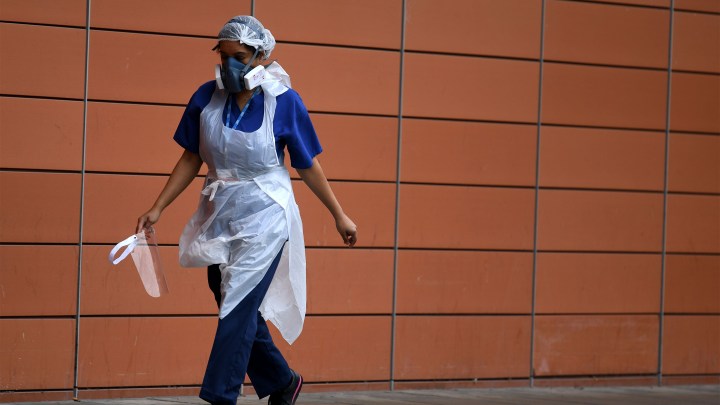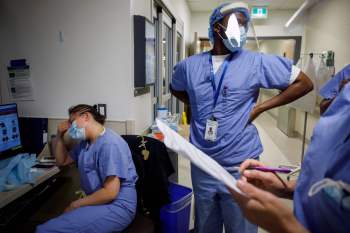
Army of 3D printers battles Britain’s shortage of PPE
Army of 3D printers battles Britain’s shortage of PPE

In the battle against COVID-19, a shortage of personal protective equipment, or PPE, in the U.K.’s National Health Service is causing scandal and outrage. Gowns, masks and visors are in short supply, putting the lives of front-line medical staff at risk. The U.K.’s main nursing union and professional body, the Royal College of Nursing, has even told its members to refuse to treat patients if the nurses have not been given the right protective equipment.
But various private and charitable projects are underway to make up the shortfall.

One family in north London has embarked on a mission to manufacture as many face visors as it can to donate them to hospitals, care homes and doctor’s offices. Christopher Grilli and his wife, Emily, have turned their small, pleasant, wisteria-clad house into a minifactory equipped with 3D printing machines.
“Come through here into what used to be our living room,” Grilli said as he ushered me into a small front room. “You can probably hear the printers whirring away.”

The TV, sofa and chairs had been removed, and a piano pushed to one side, to make way for 10 3D printers, all churning out the plastic headbands that hold the transparent visors in place.
Grilli, a technical designer with the Nissan car company, owns two of the printers. The other machines, costing around $250 apiece, were donated by friends. Crowdfunding has paid for the materials, and the Grilli family supplies the labor — around the clock.
“Yeah, we’ve been working through the night,” Christopher said. “Getting up, sharing our shifts. It’s like feeding the baby again. We’ve had three children already. It’s like that all over again, except we don’t have to change any diapers.”
“Changing printers instead of diapers,” Emily chipped in.
The Grillis’ minifactory is producing around 1,000 single-use visors a week, which they’re handing over for free to local hospitals and, on occasion, to individual health-care workers who turn up, distressed, on their doorstep.
“We’ve had nurses on our driveway, crying in tears … of fear and then joy when we give them 10 face visors,” Christopher recalled. “It’s been awful to watch them but really gratifying to give them what they need.”
Many hundreds of people across the U.K. have been stirred into charitable action during the coronavirus crisis. A firm called Electrocomponents, which distributes industrial and electronic products, launched a national call to arms, urging anyone with a 3D printer to join the new PPE cottage industry.

“We’ve seen all sorts of people respond,” Mike Bray, Electrocomponents’ vice-president in charge of innovation, told Marketplace. “People who are running businesses have contacted us. We’ve seen schools take up the call to arms. We’ve seen individuals from across our local communities, across the U.K., who’ve all got 3D printers, are all supporting this.”
Another organizer, Mason Rowbottom of the National 3D Printing Society, says at least 1,750 printers have been enlisted. Each one is capable of making 40 visor headbands a day, providing production capacity of at least 70,000 headbands a day.

(Photo courtesy Mason Rowbottom)
That’s more than 2 million a month. In addition, Christopher Grilli’s employer, Nissan, has joined the effort and is manufacturing another 100,000 visors a week.
Which prompts the question: is Britain now headed for a visor glut?
No way, insist Christopher and Emily Grilli. They say that almost limitless supplies of single-use visors may be required, so long as the virus remains a threat. And not just in hospitals and care homes. They believe that when the lockdown is lifted, many employers may demand that their staff members wear the protective equipment when working in close proximity with one another.
“We are going to keep our 3D printers going for the foreseeable future,” Christopher said. “So long as we can keep paying the electricity bill, we won’t stop.”
COVID-19 has fostered this new cottage industry. With the atomization of the workforce under lockdown — and the dislocation of supply chains — the 3D printer has come into its own. It’s another unexpected effect of the pandemic.
There’s a lot happening in the world. Through it all, Marketplace is here for you.
You rely on Marketplace to break down the world’s events and tell you how it affects you in a fact-based, approachable way. We rely on your financial support to keep making that possible.
Your donation today powers the independent journalism that you rely on. For just $5/month, you can help sustain Marketplace so we can keep reporting on the things that matter to you.


















